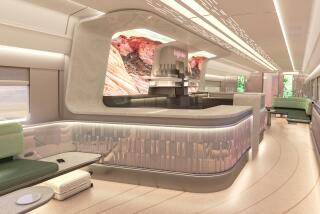High-Speed Train Network Would Benefit State, Study Says
A new environmental analysis supports a state commission’s claim that a bullet train between Los Angeles and San Francisco would attract tens of millions of riders and significantly reduce congestion on California’s highways and in the air.
But the estimated cost -- as much as $37 billion -- combined with the state’s troubled finances leaves the prospects for such a railway uncertain.
By 2020, as many as 68 million riders a year would use a high-speed train connecting Southern and Northern California, according to a draft environmental review expected to be released today.
The California High-Speed Rail Authority has been studying and promoting the concept of a bullet train for about 10 years. Planners envision a network stretching from San Diego to Sacramento, with train speeds surpassing 200 mph. A $10-billion bond measure to finance the first leg of the network is planned for the November ballot.
But faced with a severe state budget shortfall, Gov. Arnold Schwarzenegger has proposed putting off that vote.
“It’s just not prudent to go forward when we have significant budgetary pressures overall and we are not able to pursue other critical transportation needs,” H.D. Palmer, deputy director of the state Finance Department, said in an interview Monday.
State Sen. Dean Florez (D-Shafter), one of the state’s leading backers of high-speed rail, agreed that a delay might be in order, particularly since voters will be asked in March to approve Schwarzenegger’s $15-billion bond measure.
“I just don’t think it is good public policy to put this on right now,” Florez said. “People are not going to want to OK Arnold’s bonds and then have more debt coming their way in November.”
Florez proposed postponing the bullet-train bond measure until late 2006.
Mehdi Morshed, executive director of the rail authority, said he was pleased with the findings of the environmental report.
“The basic conclusion of this report is that the high-speed train is the best solution for California’s intercity travel needs,” Morshed said. “Compared to doing nothing or expanding the airports or highways, this just makes sense. There’s more capacity, it’s more comfortable, more environmentally friendly.”
The report compared building a high-speed train with two options: widening highways and expanding airports, or doing nothing at all beyond completing transportation projects that already have been approved. The report concluded that the bullet train compares favorably in terms of cost, environmental effects and convenience.
To accommodate the 68 million projected bullet-train riders without a new railway, for instance, California would need to build 2,970 additional miles of freeway lanes, nearly 60 new airport gates and five new runways. The total costs of such upgrades would reach $82 billion, according to the report.
The new analysis found that 155 million people make long-haul, city-to-city trips in California annually, a number expected to reach 253 million over the next 20 years.
The bullet train network would initially connect Los Angeles, San Jose and San Francisco, with extensions planned for San Diego and Sacramento.
The projected cost for the system has risen. The report put the figure at $33 billion to $37 billion. In 1999, the high-speed rail authority said the system would cost $25 billion. The authority planned to use the $10-billion bond measure to build the first segment, buttressing the bond with federal and local funds.
At speeds of 200 mph or more, the bullet train’s travel times would be competitive with jets, the report found. For instance, the report states that riders could make it from downtown San Francisco to downtown L.A. in 2 hours, 25 minutes. A commercial air flight between San Francisco and L.A. international airports takes 1 hour, 20 minutes.
More to Read
Sign up for Essential California
The most important California stories and recommendations in your inbox every morning.
You may occasionally receive promotional content from the Los Angeles Times.











